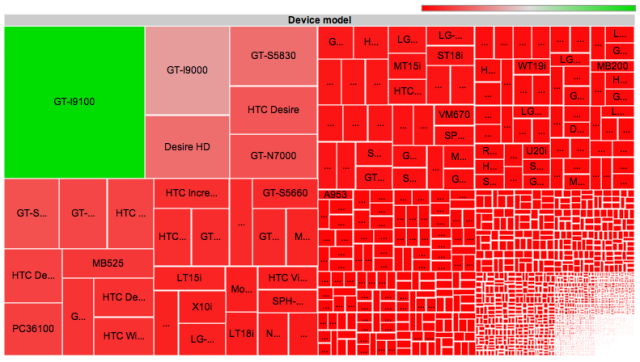
One developer can do business with nearly 4,000 distinct Android ROMs, according to data posted by the creators of OpenSignalMaps on Tuesday. While the Android platform provides a lot of flexibility to consumers, OpenSignalMaps' data drives home the point that the small army of device variations can be staggering. Market developers can miss out on a lot by not supporting less popular or older devices.
It's no secret that the Android umbrella covers many makes and models of devices, and that fragmentation is an occasionally daunting problem for developers. To see how wide a net they cast, OpenSignalMaps logged the specs of devices that downloaded the app over the course of six months. This collected info on over 680,000 devices—a significant sample, even if small compared to the many millions of Android users and devices in the world.

The developers logged 3,997 distinct devices, the most popular of which was the Samsung Galaxy S II. This figure was inflated quite a bit by custom ROMs, which overwrite the android.build.MODEL variable and cause those phones to be logged as separate devices. 1,363 types were logged only once, and while some were custom ROMs bucking the numbers, a good few were just massively unpopular devices—for example, the Hungarian 10.1-inch Concorde Tab.
It's not only the sheer count of devices that's daunting, either—the spread is also intimidating. It's easy to imagine a practical Android developer who doesn't want to waste time supporting niche devices restricting the app to require high-end hardware and recent APIs, covering only the 25 or so most popular phones, and devil take the hindmost. But in OpenSignalMaps' case, the top 25 devices don't even encompass half of the map, and would still exclude well-known and popular (if old) models like the Samsung Nexus S. The developers would be missing out on over 50 percent of the Android market.
In total, 599 brands were logged (again, thrown by custom ROMs a bit). We spotted "YouWave" in the brand visualizer, which is an Android emulator for Windows. The post also separates out screen resolutions, with about 13 commonly used configurations and a few dozen more unpopular ones. A second graphic shows iOS with only four screen resolutions to manage.
Granted, OpenSignalMaps is only one developer. Though their sample size is big, the spread of data may look wildly different for other companies depending on their user base. Still, it paints a sobering picture of the fragmentation we occasionally hear about.
Listing image by OpenSignalMaps
reader comments
133